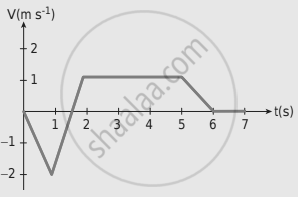Advertisements
Advertisements
प्रश्न
The following velocity-time graph represents a particle moving in the positive x-direction. Analyze its motion from 0 to 7 s. Calculate the displacement covered and distance travelled by the particle from 0 to 2 s.

उत्तर
As per the graph,
(a) From 0 to 1.5 s the particle moving in the opposite direction.
- From 1.5 s to 2 s the particle is moving with increasing velocity.
- From 2 s to 5 s velocity of the particle is constant of magnitude 1 ms -1
- From 5 s to 6 s velocity of the particle is decreasing.
- From 6 s to 7 s the particle is at rest.
(b) Distance covered by the particle – Area covered under (v -t) graph
= `1/2 xx 2 xx 1.5 + 1/2 xx 1 xx 0.5` = 1.5 m + 0.25 m = 1.75 m
Displacement of the particle
= `-1/2 xx 2 xx 1.5 + 1/2 xx 1 xx 0.5`
= -1.5 m to 0.25 m = -1.25 m
APPEARS IN
संबंधित प्रश्न
Which one of the following Cartesian coordinate systems are not followed in physics?
Explain what is meant by Cartesian coordinate system?
Explain what is meant by Cartesian coordinate system?
Explain what is meant by Cartesian coordinate system?
Define displacement.
Define distance.
A particle has its position moved from `vecr_1 = 3hati + 4hatj` to `vecr_2 = hati + 2hatj`. Calculate the displacement vector `(∆vecr)` and draw the `vecr_1, vecr_2` and `Deltavecr` vector in a two dimensional Cartesian coordinate system.
